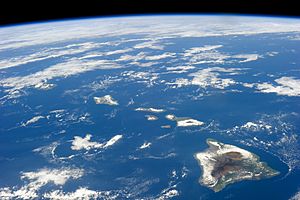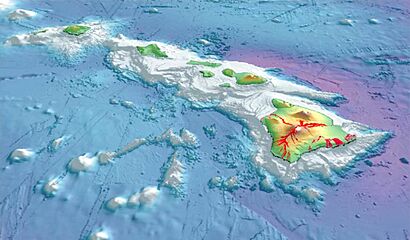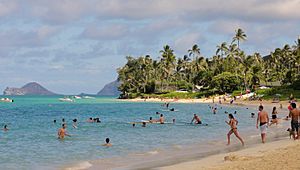Hawaiian Islands facts for kids
|
Native name:
Mokupuni Hawai‘i
|
|
|---|---|
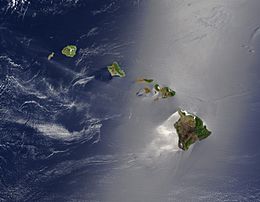
The Windward Islands of Hawaii
|
|
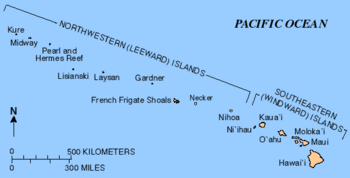 |
|
| Geography | |
| Location | North Pacific Ocean |
| Coordinates | 20°54′00″N 156°36′00″W / 20.90000°N 156.60000°W |
| Total islands | 137 |
| Highest point |
|
| Administration | |
|
United States
|
|
| State | Hawaii |
| Unincorporated territory | Midway Atoll |
| Largest settlement | Honolulu |
The Hawaiian Islands (in Hawaiian: Mokupuni Hawai‘i) are a group of many islands in the North Pacific Ocean. They stretch about 1,500 miles (2,400 kilometers) from the island of Hawaiʻi in the south to Kure Atoll in the north. Europeans once called them the "Sandwich Islands." The name "Hawaii" comes from its largest island, Hawaiʻi.
These islands are the tops of a huge underwater mountain range. This range is called the Hawaiian–Emperor seamount chain. It formed from volcanic activity over a special spot in the Earth's mantle called a hotspot. The islands are about 1,860 miles (3,000 km) from the nearest continent. They are part of Polynesia in Oceania.
The U.S. state of Hawaii includes almost all of these islands. This includes the mostly empty Northwestern Hawaiian Islands. The only island not part of the state is Midway Atoll, which is a U.S. territory. Hawaii is the only U.S. state made entirely of islands. It is also the only state not directly connected to North America. The Northwestern islands and the waters around them are protected. They are a National Monument and a World Heritage Site.
Contents
Hawaiian Islands and Reefs
People still discuss when the first settlers arrived in the Hawaiian Islands. Some old findings suggest people settled there as early as 124 AD.
Captain James Cook of the Royal Navy visited the islands on January 18, 1778. He named them the "Sandwich Islands." He did this to honor The 4th Earl of Sandwich. This name was used until the 1840s. Then, the local name "Hawaii" slowly became more common.
The Hawaiian Islands have a total land area of 6,423.4 square miles (16,636.5 km2). All of these islands and islets are part of Hawaii. Hawaii is the 50th state of the United States. The only exception is Midway, which is a U.S. territory.
Main Hawaiian Islands
The eight main islands of Hawaii are also called the Windward Islands. All of them are lived on, except for Kahoʻolawe.
Smaller Islands and Islets

The state of Hawaii has 137 "islands" in its chain. This number includes all the small islands and tiny islets near the main islands. It also includes individual islets in each atoll. Here are just a few of them:
- Kaʻula
- Kāohikaipu
- Lehua
- Mānana
- Mōkōlea Rock
- [[Mokoliʻi]]
- Moku Manu
- Mokuauia
- Moku o Loʻe
- Moku Ola
- Mokuʻumeʻume
- Molokini
- Nā Mokulua
Atolls and Reefs of Hawaii
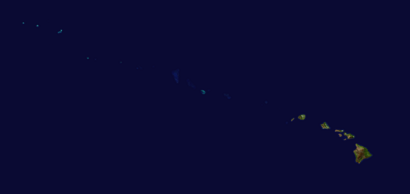
The islands, atolls, and reefs west of Niʻihau are mostly empty. Only Midway Atoll has people living on it. These are called the Northwestern Hawaiian Islands (Leeward Islands):
- Nihoa (Mokumana)
- Necker (Mokumanamana)
- French Frigate Shoals (Kānemilohaʻi)
- Gardner Pinnacles (Pūhāhonu)
- Maro Reef (Nalukākala)
- Laysan (Kauō)
- Lisianski Island (Papaʻāpoho)
- Pearl and Hermes Atoll (Holoikauaua)
- Midway Atoll (Pihemanu)
- Kure Atoll (Mokupāpapa)
Geology of the Hawaiian Islands

This chain of islands formed as the Pacific Plate slowly moved northwest. It moved over a hotspot in the Earth's mantle. This movement happened at about 32 miles (51 km) per million years. Because of this, the island in the southeast is still volcanically active. The islands at the northwest end are older and smaller. They have been worn down by erosion for a longer time.
Scientists have figured out the age of the islands using a method called potassium-argon dating. The oldest island, Kure Atoll, is about 28 million years old. The youngest island, Hawaiʻi, is about 400,000 years old. In the last 200 years, volcanoes have only been active on Hawaiʻi. Also, a growing underwater volcano called Kamaʻehuakanaloa Seamount (formerly Loʻihi) is active. The Hawaiian Volcano Observatory watches these volcanoes and shares information. Kīlauea had been erupting almost constantly since 1983, but it stopped in August 2018.
Most of the melted rock (magma) from the hotspot is basalt. So, Hawaiian volcanoes are mostly made of this type of rock. Most eruptions in Hawaiʻi are "Hawaiian-type eruptions." This means the lava flows out smoothly. This is because basalt magma is very runny. It is not like the thick magma that causes explosive eruptions in other parts of the Pacific.
Hawaiʻi island, also called the Big Island, is the largest and youngest island. It was formed by five volcanoes. Mauna Loa covers more than half of the Big Island. It is the largest shield volcano on Earth. From sea level to its top, it is over 2.5 miles (4 km) high. From the seafloor to its top, it is about 3.1 miles (5 km) high.
Earthquakes in Hawaii
The Hawaiian Islands have many earthquakes. These quakes are usually caused by volcanic activity. So, there are more earthquakes in the southern part of the island chain. Both old and new earthquake records show that bigger earthquakes happen near active volcanoes like Mauna Loa and Kilauea.
The sides of the volcanoes are under great stress. This stress comes from erosion, which causes landslides, and from magma pushing up. When the side of a volcano slips, it causes an earthquake. This type of earthquake is special because the forces causing it can change over time. This is because volcanic activity changes. Earthquakes near active volcano sides are risky. This is partly because the forces that cause them are hard to predict. Also, these quakes happen close to the surface, usually 5 to 20 km deep. This increases the danger to buildings and people. Earthquakes and landslides on the islands have also caused tsunamis.
Early earthquake monitoring happened in Hilo. Missionaries Titus Coan and Sarah J. Lyman and her family recorded them. Between 1833 and 1896, about 4 or 5 earthquakes were reported each year. Today, the Hawaiian Volcano Observatory (run by the USGS) monitors earthquakes.
From 1974 to 2003, Hawaii had 1,533 earthquakes with a magnitude of 3.5 or greater. This was 7.3% of all such earthquakes in the United States. Hawaii ranked third for the most earthquakes during this time, after Alaska and California.
On October 15, 2006, a 6.7 magnitude earthquake hit off the coast of Hawaii island. It was near the Kona area. About five minutes later, a 5.7 magnitude aftershock followed. Most of the Big Island had minor to moderate damage. Some major roads were blocked by rock slides. People in Honolulu, Oahu, felt the effects, even though it was almost 150 miles (240 km) away. Power outages lasted for hours or days. Several water pipes broke. No one died or had life-threatening injuries.
On May 4, 2018, a 6.9 magnitude earthquake happened in the active volcanic area of Kīlauea.
Tsunamis in Hawaii
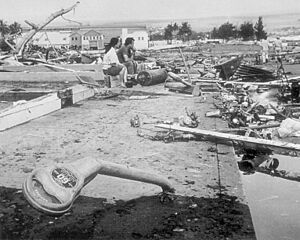
The Hawaiian Islands can be hit by tsunamis. These are huge waves that crash onto the shore. Tsunamis are most often caused by earthquakes somewhere else in the Pacific Ocean. The waves from these earthquakes travel very fast, about 400–500 miles per hour (600–800 km/h). They can affect coastal areas thousands of miles away.
Tsunamis can also start from the Hawaiian Islands themselves. Big volcanic eruptions can cause tsunamis. The island of Molokaʻi had a huge landslide over a million years ago. This underwater landslide likely caused tsunamis. The Hilina Slump on the island of Hawaiʻi is another place where a large landslide could happen and cause a tsunami.
The city of Hilo on the Big Island has been hit hardest by tsunamis. This is because the shape of Hilo Bay makes the incoming water even stronger. Coastal cities have tsunami warning sirens to alert people.
On February 27, 2010, a tsunami from an earthquake in Chile hit the islands. It was not very big. But local emergency officials used new technology and ordered evacuations. This was to prepare for a possible major event. The Governor said it was a "good drill" for the next big event.
On March 11, 2011, a tsunami from an earthquake in Japan hit the islands. It was also not very big. But local officials ordered evacuations to prepare for a possible major event. This tsunami caused about $30.1 million in damages.
Volcanoes of Hawaii
Only the two Hawaiian islands furthest to the southeast have active volcanoes. These are Haleakalā on Maui, and Mauna Loa, Mauna Kea, Kilauea, and Hualalai, all on the Big Island. The volcanoes on the other islands are no longer active. This is because they have moved away from the Hawaii hotspot. The Kamaʻehuakanaloa Seamount is an active underwater volcano. Scientists expect it to become the newest Hawaiian island in 10,000 to 100,000 years.
Dangers from these volcanoes include lava flows that can destroy land. There are also volcanic gases, earthquakes, and tsunamis. Underwater eruptions can affect the ocean. There is also a chance of an explosive eruption.
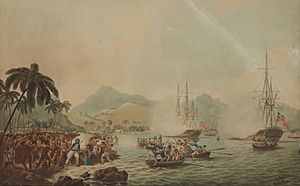
History of the Hawaiian Islands
The first people to settle Hawaii were Polynesians. They traveled across the ocean in canoes. Over time, they developed their own unique culture and way of life.
In 1778, Captain James Cook arrived. This marked the start of more contact with Europeans. Soon, traders and missionaries came to the islands. This led to big changes in Hawaiian society. The Hawaiian Kingdom was formed in 1810, uniting all the islands under one ruler.
Later, the United States became interested in Hawaii. In 1893, the Hawaiian monarchy was overthrown. Hawaii became a U.S. territory in 1898. Finally, in 1959, Hawaii became the 50th state of the United States.
Ecology and Wildlife
The Hawaiian Islands are home to many unique plants and animals. These are called endemic species. They are found nowhere else in the world.
When humans first settled, they brought new trees, plants, and animals. These included rats and pigs. These new animals hunted native birds and insects. These native species had not evolved to deal with such predators. As more people arrived, especially from Europe and America, forests were cut down. This led to deforestation and damage to the environment. Many species that depended on the forests died out. Many more species are now endangered.
When Europeans arrived, they started large-scale farming and raising livestock. This meant even more forests were cleared. Towns grew, and many more species became extinct. As of 2009, many of the remaining unique species are considered endangered.
National Monument
On June 15, 2006, President George W. Bush created the Papahānaumokuākea Marine National Monument. This monument protects the northwestern Hawaiian Islands and the waters around them. It became the largest marine wildlife reserve in the world at that time.
In August 2010, UNESCO added Papahānaumokuākea to its list of World Heritage Sites. On August 26, 2016, President Barack Obama made the monument much larger. He quadrupled its original size.
Climate of Hawaii
The Hawaiian Islands have a tropical climate. But they also have many different climates. This depends on how high up a place is and what is around it. The islands get most of their rain from trade winds. These winds blow on the north and east sides (the windward side). This happens because of orographic precipitation, where mountains force air to rise and cool. Coastal areas, especially on the south and west sides (leeward sides), tend to be drier.
Generally, the lowlands of the Hawaiian Islands get most of their rain during the winter months (October to April). Drier weather usually lasts from May to September. Tropical storms and occasional hurricanes tend to happen from July through November.
During the summer, the average temperature is about 84 °F (29 °C). In the winter, it is about 79 °F (26 °C). Since the temperature stays fairly steady all year, there is a low chance of dangerous thunderstorms.
See also
 In Spanish: Archipiélago de Hawái para niños
In Spanish: Archipiélago de Hawái para niños


